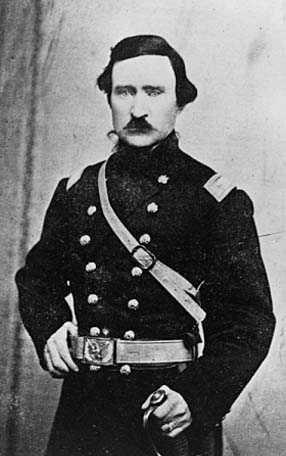Alexander Wilkin facts for kids
Alexander Wilkin (born December 1, 1819 – died July 14, 1864) was an important soldier. He fought in the Mexican–American War and the American Civil War. Wilkin also helped develop the Minnesota Territory. He was its second secretary from 1851 to 1853. In 1861, he joined the Civil War. He sadly died during the Battle of Tupelo.
Contents
Life of Alexander Wilkin
Wilkin was born on December 1, 1819, in Goshen, New York. His father, Samuel J. Wilkin, and his grandfather, James W. Wilkin, were both politicians. Alexander studied law at Yale and became a lawyer.
Early Military Service
In 1847, he joined the Tenth United States Army as a captain. His army unit went to Northern Mexico. Wilkin did not see much fighting. But he became known as a serious and respected soldier.
Moving to Minnesota
On March 6, 1848, he left the army. In 1849, he moved to Saint Paul, in the Minnesota Territory. Two years later, President Millard Fillmore made him the territorial secretary of Minnesota. This job was likely a political favor. Wilkin was a member of the Whig Party. He served in this role until 1853.
While living in St. Paul, Wilkin invested in land, railroads, and newspapers. He worked as a lawyer and an insurance agent. He also started the St. Paul Fire and Marine Insurance Company. This company later became Travelers Insurance.
Civil War Service
When the Civil War began in April 1861, Wilkin was chosen to lead the "Pioneer Guard." This was a local military group in St. Paul. On July 21, 1861, Wilkin fought in the Battle of Bull Run. The Union forces lost this battle. But Wilkin showed great bravery. Because of this, he was made a captain in the regular army.
Before he could report, he was promoted to major. He joined the 2nd Minnesota Volunteer Infantry. This new group was based in Lebanon, Kentucky. They fought in the Battle of Mill Springs on January 18, 1862. Later, Wilkin's group helped in a siege in Corinth, Mississippi. He served with General William Tecumseh Sherman.
Soon after, the 9th Minnesota Volunteer Infantry Regiment chose him as their colonel. On December 26, 1862, he commanded nearly 250 soldiers in Mankato, Minnesota. This was during a difficult historical event involving the Dakota people. He then set up his headquarters and a military training school in St. Peter.
Final Battles and Death
In October 1863, the Ninth Minnesota regiment went to Missouri. The next May, the regiment marched to Memphis, Tennessee. They formed an army to stop Nathan Bedford Forrest's cavalry. On June 10, 1864, Wilkin fought at the Battle of Brice's Cross Roads. He was praised for his bravery, even though the Confederates won.
On July 14, 1864, he faced his last battle. Another army group decided to fight Forrest. This group, led by Wilkin, went to Tupelo, Mississippi. There, he was shot and killed while talking to another soldier. He was first buried near where he fell. But his family later moved his remains to Goshen, New York, where he was born.
His father, Samuel Wilkin, lived for 20 more months after Alexander died. He passed away in 1866. In 1868, Wilkin County, Minnesota, was named to honor Alexander Wilkin. A statue of him was put up in the state capitol in 1910.
Images for kids



